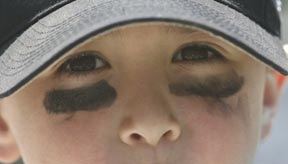Who isn’t transfixed by the sight of a preschooler dressed in full football gear — head bobbing beneath an oversized helmet, eyes intense as he dutifully runs, in miniature cleats, into the wrong end zone?
 Little Johnny is one of more than 30 million youngsters who participate in non-school sports such as football, baseball and soccer, many starting as young as 3, according to the National Alliance for Youth Sports. And he could become one of those who lose interest in sports by middle school, says a University of Alabama at Birmingham physical education expert and youth coach.
Little Johnny is one of more than 30 million youngsters who participate in non-school sports such as football, baseball and soccer, many starting as young as 3, according to the National Alliance for Youth Sports. And he could become one of those who lose interest in sports by middle school, says a University of Alabama at Birmingham physical education expert and youth coach.
Sports is a great way for young children to learn about teamwork and discipline, experts say, and can provide 60 minutes of physical activity each day that the Centers for Disease Control and Prevention recommends for children and adolescents. But as in all things, moderation and good judgment need to be your guide.
Well-meaning, but overzealous parents can ruin team sports for kids, says Sandra Sims, Ph.D., associate professor of human studies in the UAB School of Education.
“I don’t think any adult would do this purposefully, but some have taken the joy away, and that is killing sports,” says Sims who has worked as a middle- and high-school teacher and coach for 20 years.
Athletes have two needs, Sims says — to have fun and feel worthy. She suggests ways you can fulfill those needs for your child athlete:
Let a child be a child – They may look cute in those little sports uniforms, but children 6 and younger need unstructured play. Period. Sims says at that age, they are not developmentally ready to compete and have regimented practices and games.
“They want to pick up grass, throw rocks or play with butterflies because that is what a child does,” she says. “Parents are saying, ‘You are going to be an NFL star’ to their 2-year-old. We often treat them as mini adults.”
Mix it up: Most children should not commit, or specialize, in one sport until they are 15 years old, Sims says. Let them try various sports to see the ones they like best.
She recommends that parents let their child complete a season in one sport and then evaluate it and talk about exploring other choices.
And don’t worry that waiting will negatively affect their chances of getting a scholarship, Sims says. Switching sports lets your child to decide which they like best and are most willing to work at to excel in, she says.
Get them off the bench: Being on a sports team doesn’t mean your child is fit, she says. Wearing a uniform does not mean they will get 60 minutes of physical activity each day. This depends on the sport, the position they play and how much time they get on the field.
Make sure your child still gets time to run and play, she says. And, if they are spending hours in practice each day with no physical benefit, you may want to consider switching.
Use good parenting sense: If your child has late practices, gets little rest and eats dinner on the run, ask yourself if this is in his or her best interest. Stop and evaluate the motivation behind your drive to keep up with their rigorous sports schedule. Is this your child’s dream or yours?
When picking a little league team, do your research: Little league coaches are devoted volunteers who can help your kids get exercise and create wonderful childhood memories, but keep in mind that they are not sports experts.
“Youth sports are wonderful,” Sims says, “but untrained coaches can be very harmful.”
Make sure that the person leading your child’s team has realistic expectations and has had proper training in handling injuries, stretching exercises, conducting practices, etc. Stretching exercises that a coach may have used back in the 1970s are now considered harmful, she says. The National Center for Sports Safety has helpful information and a training video for league coaches and parents.
Remember to have fun: Be sure to balance the work with the “fun factor,” Sims says. The main reason children choose to quit sports is because it is not fun anymore, she says.
“If it becomes a job and they hate to play, they will walk away,” she says, “and that is sad.”